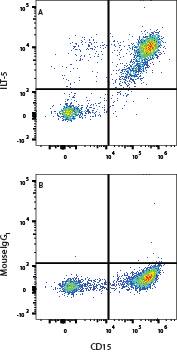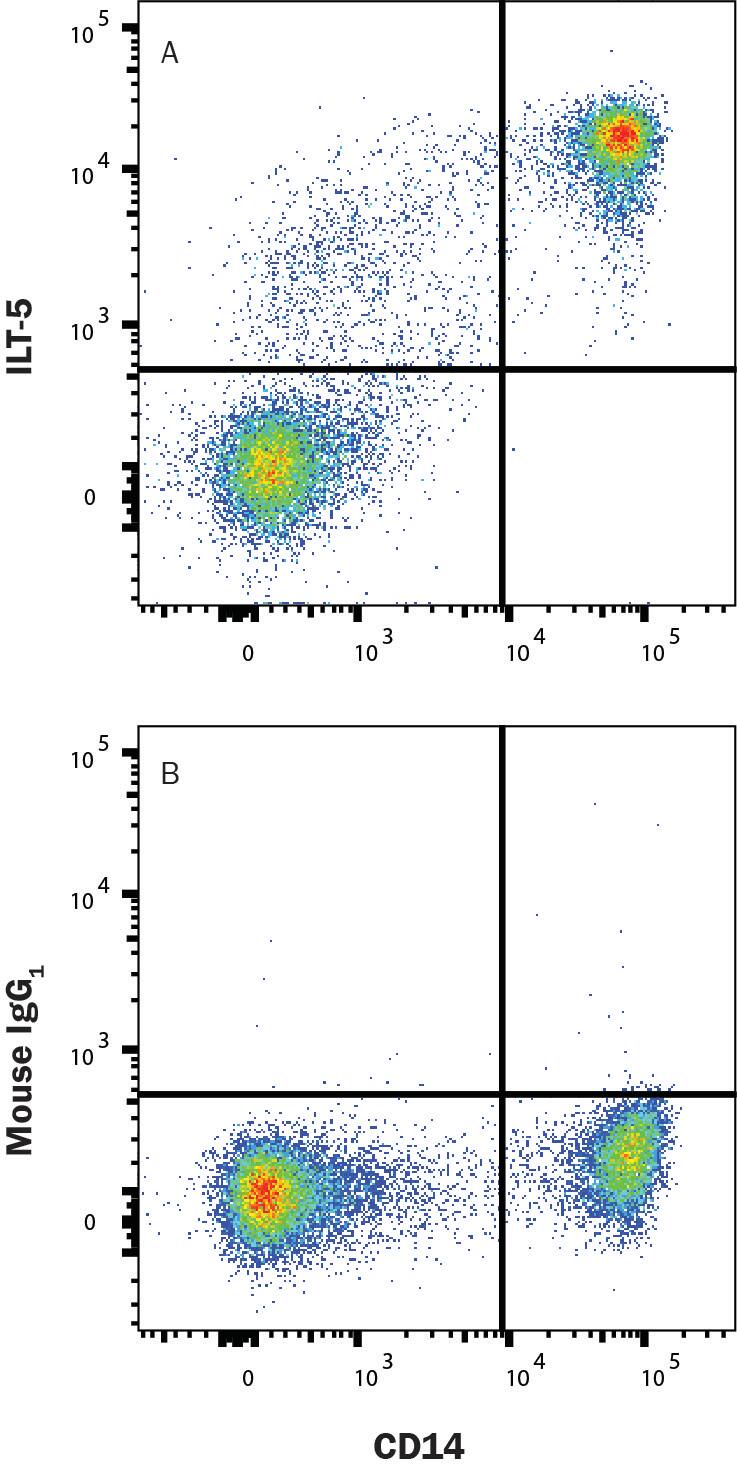Human LILRB3/CD85a/ILT5 Antibody
R&D Systems, part of Bio-Techne | Catalog # MAB18061


Conjugate
Catalog #
Key Product Details
Species Reactivity
Human
Applications
Flow Cytometry
Label
Unconjugated
Antibody Source
Monoclonal Mouse IgG1 Clone # 1057017
Product Specifications
Immunogen
Human embryonic kidney cell, HEK293-derived human LILRB3/CD85a/ILT5
Gly24-Glu443
Accession # O75022
Gly24-Glu443
Accession # O75022
Specificity
Detects human LILRB3/CD85a/ILT5 in direct ELISA.
Clonality
Monoclonal
Host
Mouse
Isotype
IgG1
Scientific Data Images for Human LILRB3/CD85a/ILT5 Antibody
Detection of LILRB3/CD85a/ILT5 in human neutrophils with CD15 costain cells by Flow Cytometry.
Human neutrophils with CD15 costain cells were stained with Mouse Anti-Human/Mouse SSEA-1 PE-conjugated Monoclonal Antibody (Catalog # FAB2155P) and either (A) Mouse Anti-Human LILRB3/CD85a/ILT5 Monoclonal Antibody (Catalog # MAB18061) or (B) Mouse IgG1 Isotype Control (Catalog # MAB002) followed by Allophycocyanin-conjugated Anti-Mouse IgG Secondary Antibody (Catalog # F0101B). View our protocol for Staining Membrane-associated Proteins.Detection of LILRB3/CD85a/ILT5 in PBMC with CD14 costain cells by Flow Cytometry.
PBMC with CD14 costain were stained with either (A) Mouse Anti-Human LILRB3/CD85a/ILT5 Monoclonal Antibody (Catalog # MAB18061) or (B) Mouse IgG1 Isotype Control (Catalog # MAB002). View our protocol for Staining Membrane-associated Proteins.Applications for Human LILRB3/CD85a/ILT5 Antibody
Application
Recommended Usage
Flow Cytometry
0.25 µg/106 cells
Sample: Human neutrophils with CD15 costain and PBMCs with CD14 costain
Sample: Human neutrophils with CD15 costain and PBMCs with CD14 costain
Formulation, Preparation, and Storage
Purification
Protein A or G purified from hybridoma culture supernatant
Reconstitution
Reconstitute at 0.5 mg/mL in sterile PBS. For liquid material, refer to CoA for concentration.
Formulation
Lyophilized from a 0.2 μm filtered solution in PBS with Trehalose. *Small pack size (SP) is supplied either lyophilized or as a 0.2 µm filtered solution in PBS.
Shipping
Lyophilized product is shipped at ambient temperature. Liquid small pack size (-SP) is shipped with polar packs. Upon receipt, store immediately at the temperature recommended below.
Stability & Storage
Use a manual defrost freezer and avoid repeated freeze-thaw cycles.
- 12 months from date of receipt, -20 to -70 °C as supplied.
- 1 month, 2 to 8 °C under sterile conditions after reconstitution.
- 6 months, -20 to -70 °C under sterile conditions after reconstitution.
Background: LILRB3/CD85a/ILT5
Angiopoietin-like 7, consistent with the demonstrated functional interactions between other members of these protein families (10). In the mouse CNS, PIR-B functions as a receptor for the myelin proteins Nogo, MAG, and OMgp and mediates their inhibitory action on neurite outgrowth and axon regeneration (11). Upon binding to MAG, PIR-B associates with TrkB and NGF R/p75 in cerebellar granule neurons (12).
References
- Thomas, R. et al. (2010) Clin. Rev. Allergy Immunol. 38:159.
- Anderson, K.J. and R.L. Allen (2009) Immunology 127:8.
- Nakayama, M. et al. (2007) J. Immunol. 178:4250.
- Tedla, N. et al. (2003) Proc. Natl. Acad. Sci. USA 100:1174.
- Sloane, D.E. et al. (2004) Blood 104:2832.
- Tedla, N. et al. (2008) J. Leukoc. Biol. 83:334.
- Uehara, T. et al. (2001) J. Clin. Invest. 108:1041.
- Mori, Y. et al. (2008) J. Immunol. 181:4742.
- Jones, D.C. et al. (2016) Oncotarget PMID 26769854.
- Zheng, J. et al. (2012) Nature 485:656.
- Atwal, J.K. et al. (2008) Science 322:967.
- Fujita, Y. et al. (2011) Cell Death Dis. 2:e198.
Alternate Names
CD85a, ILT5, LIR3
Entrez Gene IDs
11025 (Human)
Gene Symbol
LILRB3
UniProt
Additional LILRB3/CD85a/ILT5 Products
Product Documents for Human LILRB3/CD85a/ILT5 Antibody
Product Specific Notices for Human LILRB3/CD85a/ILT5 Antibody
For research use only
